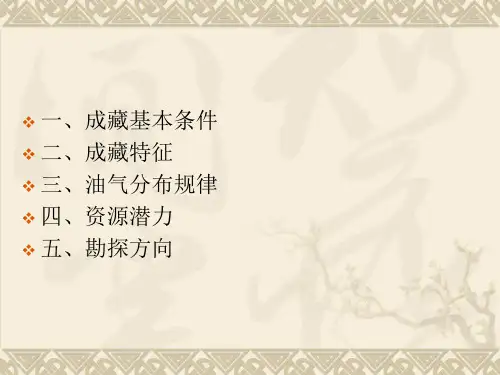《鄂尔多斯盆地》课件
- 格式:ppt
- 大小:13.30 MB
- 文档页数:16


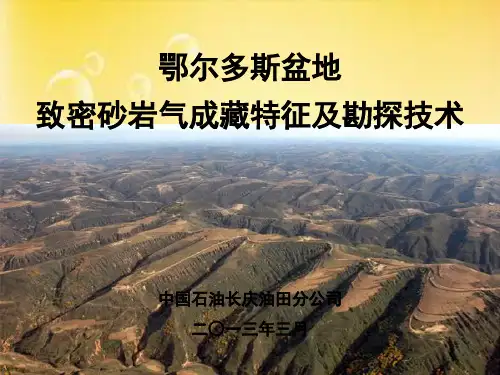
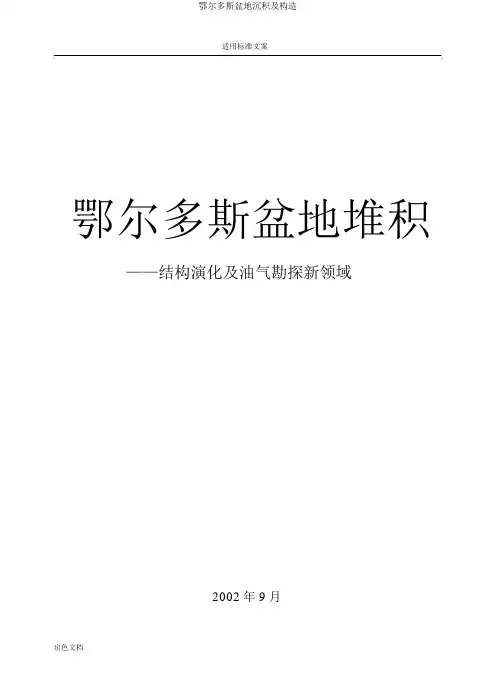
适用标准文案鄂尔多斯盆地堆积——结构演化及油气勘探新领域2002年 9月目录序言一.地背景与结构演化(一)地背景⋯⋯⋯⋯⋯⋯⋯⋯⋯⋯⋯⋯⋯⋯⋯⋯⋯⋯⋯⋯⋯⋯⋯1(二)结构演化⋯⋯⋯⋯⋯⋯⋯⋯⋯⋯⋯⋯⋯⋯⋯⋯⋯⋯⋯⋯⋯⋯⋯2二.鄂多斯盆地古生代—中生代沉演化(一)奥陶系沉系统区分及岩相古地理演化⋯⋯⋯⋯⋯⋯⋯⋯⋯⋯4(二)石炭—二叠沉系统区分及岩相古地理演化⋯⋯⋯⋯⋯⋯⋯10(三)中生界沉系统区分及岩相古地理演化⋯⋯⋯⋯⋯⋯⋯⋯⋯⋯18三.鄂多斯盆地下古生界奥陶系生、、盖特色及天然气富集律(三)源岩特色⋯⋯⋯⋯⋯⋯⋯⋯⋯⋯⋯⋯⋯⋯⋯⋯⋯⋯⋯⋯⋯⋯25(四)集岩特色⋯⋯⋯⋯⋯⋯⋯⋯⋯⋯⋯⋯⋯⋯⋯⋯⋯⋯⋯⋯⋯⋯33(五)盖特色⋯⋯⋯⋯⋯⋯⋯⋯⋯⋯⋯⋯⋯⋯⋯⋯⋯⋯⋯⋯⋯⋯⋯44(六)天然气富集律⋯⋯⋯⋯⋯⋯⋯⋯⋯⋯⋯⋯⋯⋯⋯⋯⋯⋯⋯⋯四.多斯盆地上古生界生、特色及天然气富集律(一)源岩特色⋯⋯⋯⋯⋯⋯⋯⋯⋯⋯⋯⋯⋯⋯⋯⋯⋯⋯⋯⋯⋯⋯55(二)集岩特色⋯⋯⋯⋯⋯⋯⋯⋯⋯⋯⋯⋯⋯⋯⋯⋯⋯⋯⋯⋯⋯⋯56(三)天然气富集律⋯⋯⋯⋯⋯⋯⋯⋯⋯⋯⋯⋯⋯⋯⋯⋯⋯⋯⋯⋯69五.鄂多斯盆地中生界生、特色及石油源价(一)源岩特色⋯⋯⋯⋯⋯⋯⋯⋯⋯⋯⋯⋯⋯⋯⋯⋯⋯⋯⋯⋯⋯⋯(二)集岩特色⋯⋯⋯⋯⋯⋯⋯⋯⋯⋯⋯⋯⋯⋯⋯⋯⋯⋯⋯⋯⋯⋯(三)石油成藏律⋯⋯⋯⋯⋯⋯⋯⋯⋯⋯⋯⋯⋯⋯⋯⋯⋯⋯⋯⋯⋯前言本课题以新理论、新思路为指导,以采集、综合剖析和总结已有成就为主,要点野外检查和岩芯察看为辅,深入、综合、总结古人研究成就,研究盆地堆积演化历史,确立生储盖组合、联合研究和总结石油地质规律和油气勘探新领域。
为了达成相关研究内容,课题构成员自合同判定以后进行了大批的资料收集,露头剖面观察,钻井岩芯察看等工作,达成了大批工作量,详细见表1。
表 1达成工作量一览表序号项目单位数目序号项目单位数目1古人研究报告资料采集本207蒲片判定片5002古人学术论文篇308粒度剖析片2003露头剖面采集条509物性剖析件1004钻井岩心剖面采集条20010报告插图幅5野外观察剖面条3011岩相古地理图幅6钻井岩芯观察井20012研究报告份1经过一年的工作获得了以下认识1.确立了奥陶系、石炭—二叠系、中生界三叠—侏罗系堆积系统种类,此中奥陶系主要为碳酸岩堆积,包含4大堆积系统,石炭—二叠系主要为陆源碎屑岩堆积,包含 6 大堆积系统,中生界侏罗系包含三大堆积系统。

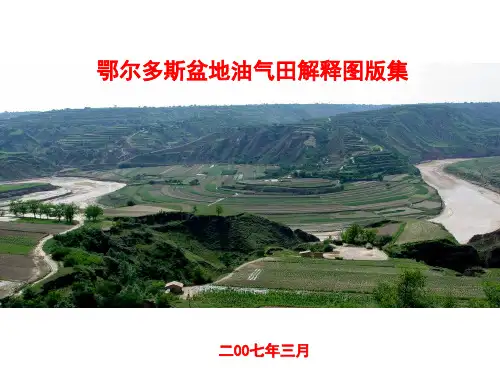
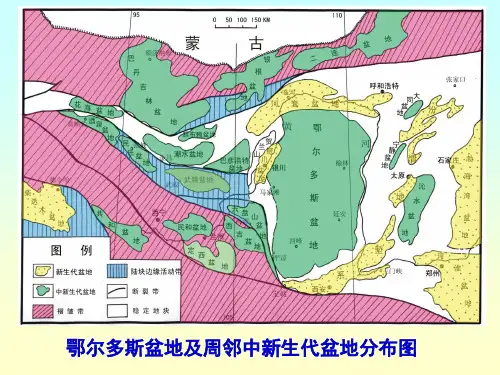
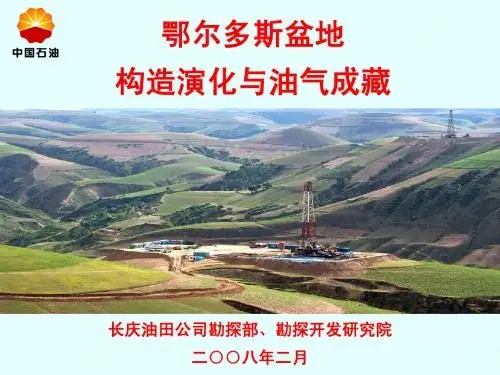
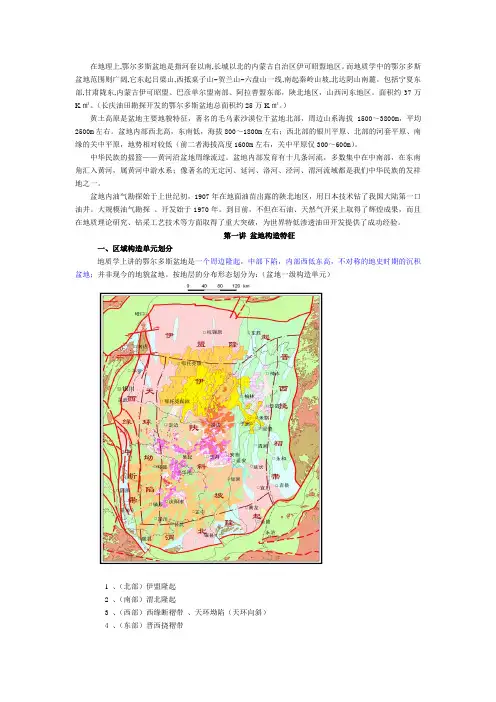
在地理上,鄂尔多斯盆地是指河套以南,长城以北的内蒙古自治区伊可昭盟地区。
而地质学中的鄂尔多斯盆地范围则广阔,它东起吕梁山,西抵桌子山~贺兰山~六盘山一线,南起秦岭山坡,北达阴山南麓。
包括宁夏东部,甘肃陇东,内蒙古伊可昭盟、巴彦单尔盟南部、阿拉善盟东部,陕北地区,山西河东地区。
面积约37万K㎡。
(长庆油田勘探开发的鄂尔多斯盆地总面积约25万K㎡。
)黄土高原是盆地主要地貌特征,著名的毛乌素沙漠位于盆地北部,周边山系海拔1500~3800m,平均2500m左右。
盆地内部西北高,东南低,海拔800~1800m左右;西北部的银川平原、北部的河套平原、南缘的关中平原,地势相对较低(前二者海拔高度1600m左右,关中平原仅300~600m)。
中华民族的摇篮——黄河沿盆地周缘流过。
盆地内部发育有十几条河流,多数集中在中南部,在东南角汇入黄河,属黄河中游水系;像著名的无定河、延河、洛河、泾河、渭河流域都是我们中华民族的发祥地之一。
盆地内油气勘探始于上世纪初,1907年在地面油苗出露的陕北地区,用日本技术钻了我国大陆第一口油井。
大规模油气勘探、开发始于1970年。
到目前,不但在石油、天然气开采上取得了辉煌成果,而且在地质理论研究、钻采工艺技术等方面取得了重大突破,为世界特低渗透油田开发提供了成功经验。
第一讲盆地构造特征一、区域构造单元划分地质学上讲的鄂尔多斯盆地是一个周边隆起,中部下陷,内部西低东高,不对称的地史时期的沉积盆地;并非现今的地貌盆地。
按地层的分布形态划分为:(盆地一级构造单元)1 、(北部)伊盟隆起2 、(南部)渭北隆起3 、(西部)西缘断褶带、天环坳陷(天环向斜)4 、(东部)晋西挠褶带5 、(中部)陕北斜坡(西倾单斜构造)陕北斜坡是目前我们研究时间最长、认识比较清楚的一个一级构造单元。
由于它的存在,盆地内同一个时期的地层(同一套储层),在西部埋藏深度大,东部埋藏浅。
例如:马岭油田主力含油层延10在庆阳埋深1400m左右,在延安出露地表,西峰油田的长8油层在陇东埋深2200多米,在陕北延河入黄河口处则高悬在山崖上。
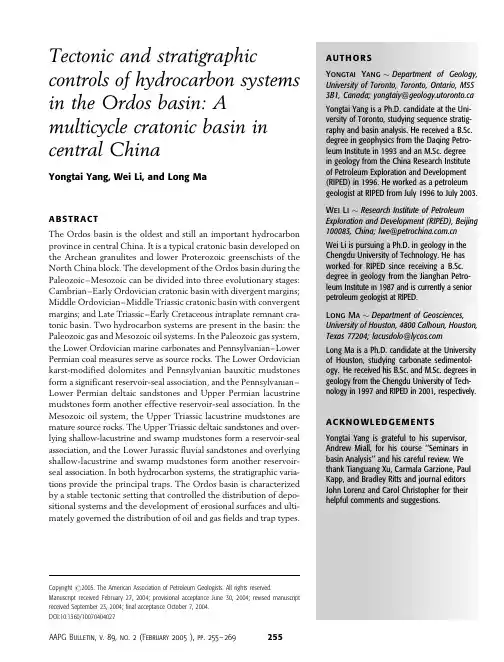
AUTHO RSYongtai Yang $Department of Geology,University of Toronto,Toronto,Ontario,M5S 3B1,Canada;yongtaiy@geology.utoronto.ca Yongtai Yang is a Ph.D.candidate at the Uni-versity of Toronto,studying sequence stratig-raphy and basin analysis.He received a B.Sc.degree in geophysics from the Daqing Petro-leum Institute in 1993and an M.Sc.degree in geology from the China Research Institute of Petroleum Exploration and Development (RIPED)in 1996.He worked as a petroleum geologist at RIPED from July 1996to July 2003.Wei Li $Research Institute of Petroleum Exploration and Development (RIPED),Beijing 100083,China;lwe@ Wei Li is pursuing a Ph.D.in geology in the Chengdu University of Technology.He has worked for RIPED since receiving a B.Sc.degree in geology from the Jianghan Petro-leum Institute in 1987and is currently a senior petroleum geologist at RIPED.Long Ma $Department of Geosciences,University of Houston,4800Calhoun,Houston,Texas 77204;lacusdolo@ Long Ma is a Ph.D.candidate at the University of Houston,studying carbonate sedimentol-ogy.He received his B.Sc.and M.Sc.degrees in geology from the Chengdu University of Tech-nology in 1997and RIPED in 2001,respectively.ACKNOWLEDGEMENTSYongtai Yang is grateful to his supervisor,Andrew Miall,for his course ‘‘Seminars in basin Analysis’’and his careful review.We thank Tianguang Xu,Carmala Garzione,Paul Kapp,and Bradley Ritts and journal editors John Lorenz and Carol Christopher for their helpful comments and suggestions.Tectonic and stratigraphiccontrols of hydrocarbon systems in the Ordos basin:Amulticycle cratonic basin in central ChinaYongtai Yang,Wei Li,and Long MaABSTRACTThe Ordos basin is the oldest and still an important hydrocarbon province in central China.It is a typical cratonic basin developed on the Archean granulites and lower Proterozoic greenschists of the North China block.The development of the Ordos basin during the Paleozoic–Mesozoic can be divided into three evolutionary stages:Cambrian–Early Ordovician cratonic basin with divergent margins;Middle Ordovician–Middle Triassic cratonic basin with convergent margins;and Late Triassic–Early Cretaceous intraplate remnant cra-tonic basin.Two hydrocarbon systems are present in the basin:the Paleozoic gas and Mesozoic oil systems.In the Paleozoic gas system,the Lower Ordovician marine carbonates and Pennsylvanian–Lower Permian coal measures serve as source rocks.The Lower Ordovician karst-modified dolomites and Pennsylvanian bauxitic mudstones form a significant reservoir-seal association,and the Pennsylvanian–Lower Permian deltaic sandstones and Upper Permian lacustrine mudstones form another effective reservoir-seal association.In the Mesozoic oil system,the Upper Triassic lacustrine mudstones are mature source rocks.The Upper Triassic deltaic sandstones and over-lying shallow-lacustrine and swamp mudstones form a reservoir-seal association,and the Lower Jurassic fluvial sandstones and overlying shallow-lacustrine and swamp mudstones form another reservoir-seal association.In both hydrocarbon systems,the stratigraphic varia-tions provide the principal traps.The Ordos basin is characterized by a stable tectonic setting that controlled the distribution of depo-sitional systems and the development of erosional surfaces and ulti-mately governed the distribution of oil and gas fields and trap types.AAPG Bulletin,v.89,no.2(February 2005),pp.255–269255Copyright #2005.The American Association of Petroleum Geologists.All rights reserved.Manuscript received February 27,2004;provisional acceptance June 30,2004;revised manuscript received September 23,2004;final acceptance October 7,2004.DOI:10.1360/10070404027INTRODUCTIONThe Ordos basin,with an area of320,000km2(about 124,000mi2),is situated in the western part of the North China block and is bordered to the north,east, south,and west by the Yin,Luliang,Qinling,Liupan, and Helan mountains,respectively(Figure1).The ear-liest oil discovery in China was made in1907in the Ordos basin,but significant hydrocarbon discoveries were not made until the past two to three decades.At present,the increase in proven in-place hydrocarbon re-serves in the basin has become one of the highest among the Chinese petroliferous basins.It is anticipated that before2010,proven in-place gas and oil reserves in the basin will reach50–70tcf and14–18billion bbl, respectively(Hu and He,2001).Sun et al.(1989)provided a review of the evolution of the Ordos basin,which has become a base for later studies in the basin.However,some nonplate tectonic terminologies in this paper,such as‘‘early Paleozoic marine carbonate platform stage with a geosyncline-platform tectonic regime,’’‘‘late Paleozoic to early Me-sozoic intermediate stage characterized by the change from marine facies to inland basinal facies,’’and‘‘Me-sozoic polycyclic inland basin,’’hinder our understanding of the unique geology of the basin in depth.Recently, some studies have been carried out both on the regional tectonics of China and the surrounding areas of the Ordos basin(e.g.,Yin and Nie,1996;Yue et al.,2001) and on the petroleum geology in the basin(e.g.,Zhao et al.,1996;Wang and Al-Aasm,2002).However,no detailed hydrocarbon system study has been published so far.On the basis of recent valuable knowledge on re-gional geology,petroleum geology,and important hy-drocarbon discoveries in the Ordos basin,this paper attempts to review the tectonic and sedimentary evo-lution of the basin,describe the main characteristics of the Paleozoic gas and Mesozoic oil systems,and analyze tectonic and stratigraphic controls of these hydrocar-bon systems.BASIN EVOLUTIONThe North China block consists of a double-layered base-ment:the lower layer of the Archean igneous and meta-morphic rocks,including granulites,migmatitic gran-ites,and gneissic granites,with isotopic ages older than 2500Ma and the upper layer of the lower Proterozoic metamorphic rocks,including greenschists,phyllites, marbles,and metamorphosed volcanic rocks,with iso-topic ages older than1700Ma(Zhang et al.,1980).As a polycyclic basin,the Ordos basin experienced a long geological history from the middle Proterozoic to the Tertiary.As a result,thick sediments were deposited, with an average thickness of4–5km(about2.5–3.0mi) and a maximum thickness of greater than10km(about 6mi)at its western margin(Figure2).This paper mainly concentrates on the basin evolution during the deposi-tion of the Paleozoic and Mesozoic strata,in which all hydrocarbons of the basin were generated and accu-mulated(Figure3).Cambrian–Early Ordovician Cratonic basin with Divergent MarginsTectonicsFrom the Cambrian to the Early Ordovician,divergent continental margins were developed around the North China block,with the paleo-Asian sea at the northern side and the paleo-Qinling sea at the southern side (Sun et al.,1989;Yue et al.,2001)(Figure4).StratigraphyFrom the Cambrian to the early period of the Early Or-dovician,shallow-marine and tidal-flat sediments were extensively deposited on the North China block,includ-ing dolomites,oomicrites,and minor clastic rocks with a thickness of about300–600m(about1000–2000ft) in the main part of the Ordos basin(Sun et al.,1989).During the late Early Ordovician,the North China block experienced a large-scale marine transgression, leading to the deposition of the Majiagou Formation, which consists of dolomites,limestones,and evaporites, and has a thickness of1000–2000m(about3200–6500ft)in the Helan aulacogen and100–900m(about 320–3000ft)in the interior of the Ordos basin(Zhai et al.,2002)(Figures3A,4).The lower part of the Majiagou Formation consists of open platform lime-stones deposited during maximum transgression.During the deposition of the upper Majiagou Formation,marine regression resulted in extensive platform evaporative facies in the basin(Feng et al.,1998;Wang and Al-Aasm, 2002).In the central part of the basin,gypsiferous do-lomite microfacies were developed,extending from south to north,with an east-west width of60–70km (about37–43mi),a north-south length of210km(about 130mi),and an area of15,000km2(about5800mi2).A sequence of mud-sized to silt-sized crystalline dolo-mites interbedded with muddy dolomites was also256Tectonic and Stratigraphic Controls of Hydrocarbon Systems in the Ordos BasinF i g u r e 1.(A )S i m p l i f i e d t e c t o n i c m a p o f C h i n a ,s h o w i n g m a j o r f e a t u r e s d i s c u s s e d i n t h e t e x t a n d l o c a t i o n o f t h e O r d o s b a s i n (m o d i f i e d f r o m Z h o u a n dG r a h a m ,1996).(B )I n d e x m a p o f t h e O r d o s b a s i n i n c l u d i n g d i s c o v e r e d o i l a n d g a s f i e l d s a n d s t r u c t u r e c o n t o u r s o f t h e T r i a s s i c t o p (c o m p i l e d f r o m Z h a i ,1990;Q i u a n d G o n g 1999;L i a n d L u ,2002;H e e t a l.,2003).Yang et al.257deposited.These dolomites generally contain readily soluble minerals,i.e.,nodular gypsum,gypsum detri-tus,and crystalline halite,which are favorable for the later formation of secondary dissolution pores (Feng et al.,1998).Middle Ordovician–Middle Triassic Cratonic basin with Convergent MarginsTectonicsFrom the Middle Ordovician to the Mississippian,sedi-mentation was interrupted in the North China block except along its marginal areas,forming a regionally extensive unconformity (Figure 2).The regional un-conformity can be attributed to the synchronicity of two active margins of the North China block,the subduc-tions of the Qaidam block to the south and the paleo-Asian ocean plate to the north,during the Middle Ordovician–Silurian (Yin and Nie,1996)(Figure 1A).During the Pennsylvanian–Early Permian,the North Tarim–North China block began colliding with the Siberia microcontinent and Mongolian arcs (Yin and Nie,1996)(Figure 1A).The Yin Mountains were grad-ually folded and uplifted in the northern part of the block,becoming the main sediment source for the Ordos area.Simultaneously,the South China block be-gan subducting underneath the North China block (Watson et al.,1987;Yin and Nie,1996).It was sug-gested that the collision between the North and South China blocks was a diachronous event,which initiated from the east during the Late Permian and progres-sively migrated to the west during the Triassic (Yang et al.,1991;Li et al.,1993;Yin and Nie,1993).From the Late Permian to the Middle Triassic,the South China block was also subducting underneath the Qiangtang block (Yin and Nie,1996).A remnant ocean basin de-veloped in the Songpan–Ganzi region between the North China block,the South China block,and the Qiangtang block (Ingersoll et al.,1995;Zhou and Gra-ham,1996)(Figure 1A).StratigraphyDuring the hiatus from the Middle Ordovician to the Mississippian,intense meteoric leaching and karstifica-tion of the Ordovician dolomites resulted in the formation of a karst slope inclined to the east in the central part of the basin,in which the reservoir rocks of the Ordo-vician gas field developed (Figure 4).During the Pennsylvanian,the North China block experienced a relatively large-scale transgression,andF i g u r e 2.G e o l o g i c a l c r o s s s e c t i o n i n t h e O r d o s b a s i n (m o d i f i e d f r o m L i a n d L u ,2002).L o c a t i o n o f t h e s e c t i o n i s s h o w n i n F i g u r e 1B .T h e s t r a t i g r a p h y w a s i n t e r p r e t e d f r o m t h e s e i s m i c p r o f i l e s a n d w e l l d a t a .I t i s i n d i c a t e d t h a t t h e P a l e o z o i c –M e s o z o i c s t r a t a i n t h e p r i n c i p a l p a r t o f t h e b a s i n d i p g e n t l y t o t h e w e s t w i t h a n a n g l e o f l e s s t h a n 1j ,a n d m o s t o f o i l a n d g a s p o o l s a r e s t r a t i g r a p h i c t r a p s .258Tectonic and Stratigraphic Controls of Hydrocarbon Systems in the Ordos BasinF i g u r e 3.S t r a t i g r a p h i c c o l -u m n s ,d e p o s i t i o n a l e n v i r o n -m e n t s ,a n d s o u r c e -r e s e r v o i r -s e a l a s s o c i a t i o n s i n t h e O r d o s b a s i n (A )f o r t h e L o w e r O r d o -v i c i a n –U p p e r P e r m i a n (c o m -p i l e d f r o m Z h a i ,1990;F e n g e t a l.,1998;H o n g e t a l.,1998;H e e t a l.,2003);(B )f o r t h e U p p e r T r i a s s i c –L o w e r J u r a s s i c (c o m p i l e d f r o m Z h a i ,1990;W a n g 1998).Yang et al.259deposition resumed.During the deposition of the Penn-sylvanian Benxi formation,an extensive tidal-flat en-vironment developed in the central and eastern parts of the Ordos basin,and basal bauxitic mudstones,serving as seal rocks of the Ordovician gas field,and shales interbedded with thin limestones were depos-ited (Figures 3A,5A).The depositional environments of the Pennsylvanian Taiyuan Formation were char-acterized by extensive tidal-flat and shallow-marine facies with limited deltaic sand bodies in the northern part of the basin (Figure 5B)(Fu et al.,2003).This forma-tion consists of black shales interbedded with quartzose sandstones,carbonates,and coals,and has a total thick-ness of 22–276m (about 72–900ft)(Figure 3A).During the Early Permian,extensive delta and shallow-lacustrine environments were developed in the basin (Fu et al.,2003)(Figure 5C).The Lower Permian suc-cession includes two formations,the Shanxi (37–125m [121–410ft]thick)and Xiashihezi (100–200m [328–656ft]thick)(Figure 3A).Both of them consist of fluviodeltaic sandstones interbedded with mudstones in the northern part of the basin,forming the main reservoir rocks of the upper Paleozoic gas fields,and swamp and shallow-lacustrine mudstones interbedded with coals in the central and southern parts of the basin,forming the major gas source rocks of the Paleozoic gas fields (Figures 3A,5C).Minor marine carbonates and fossils were identified in the Lower Permian succes-sion in the southern part of the basin (Tian and Zhang,1997),suggesting small-scale marine transgressions.The Upper Permian–Middle Triassic strata mainly consist of red fluvial,deltaic,and shallow-lacustrine clastic rocks deposited in an arid climate (Zhai,1990).The extensively distributed shore-shallow-lacustrine mudstones of the Xiashihezi Formation serve as seals for the upper Paleozoic gas fields (Figure 3A).During the Early–Middle Triassic,the southwestern part of the Ordos basin experienced marine transgression of the Songpan–Ganzi remnant ocean basin,represented by thin beds of littoral sandstones,mudstones,and carbonates containing marine fossil fragments (Zhang,1997).Triassic–Cretaceous Intraplate Remnant Cratonic basin TectonicsDuring the Late Triassic,the collision and convergence of the North and South China blocks and the collision of the Qiangtang block with the Eurasian plate built the Ordos basin into a complete intraplate basin.Sub-sequently,a series of orogenic movements around the Ordos basin led to a new evolutionary stage of the in-traplate remnant cratonic basin (Figure 1).During the Late Triassic,the Liupan Mountains thrust onto the southwestern Ordos area resulted in the formation of the southwestern Ordos foreland depression (Liu and Yang,2000).At the end of the Late Triassic,the cessa-tion of thrusting and subsequent erosion of the Liupan Mountains led to isostatic rebound of the Ordos basin,which produced a regional unconformity between the Triassic and the Jurassic in the basin (Liu,1998).The subduction of the Kula–Pacific plate beneath the Eur-asian plate since the Early Jurassic (Klimetz,1983)resulted in the uplift of the eastern part of theNorthFigure 4.Map of interpreted sedimentary facies during Majiagou deposition,Early Ordovician,in the Ordos basin,including (1)shallow marine;(2)dolomite flat;(3)gypsiferous dolomite flat;and (4)saline lake (modified from Zhang,1997;Qiu and Gong 1999;Zhai et al.,2002).Divergent continental margins were developed at the southern and northern sides of the North China block.The gas is mainly trapped in the karst-modified gypsiferous dolomites in the karst slope formed during the Middle Ordovician–Mississippian hiatus.260Tectonic and Stratigraphic Controls of Hydrocarbon Systems in the Ordos BasinChina block,and at the end of the Jurassic,the Luliang Mountains were formed to the east of the Ordos basin (Sun et al.,1989).During the Late Jurassic,the Lhasa block collided with the Eurasian plate(Yin and Nie, 1996),and the consequent intraplate stresses(Cloe-tingh,1988)caused the contractional deformation and led to the formation of the Helan fold-thrust belt(Liu and Yang,2000)(Figures1B,2).At the end of the Early Cretaceous,the Ordos basin,together with the peri-Pacific areas in eastern China,was uplifted(Li and Lu, 2002),resulting in the termination of sedimentation on the remnant craton(Figure2).StratigraphyDuring the Late Triassic,the southwestern fan deltas and northern deltas developed in the Ordos basin (Figures3B,5D).Clastic wedges,with a thickness more than3000m(about10,000ft),were deposited in the southwestern foreland depression,tapering to the east to less than1000m(about3200ft)in the Ordos basin(Li et al.,1995).Deltaic sand bodies in the north formed the main reservoir rocks of the Triassic oil fields.Extensive semideep and deep lacustrine facies developed in the central and southern parts of the basin, and dark-gray mudstones were deposited,forming the main Mesozoic source rocks.During the deposition of the upper part of the Yanchang Formation,exten-sive swamp and shallow-lacustrine environments de-veloped,resulting in the deposition of mudstones about 100m(about320ft)thick that serve as a regional seal of the Triassic oil pools(Figure3B).The Lower Jurassic Fuxian Formation was depos-ited in local sags formed on the pre-Jurassic erosional surface and is mainly composed of sandstones and con-glomerates of incised braided-channel systems(Wu and Xue,1992)(Figure3B).During the deposition of the lower section of the Yanan Formation,lag gravels and channel-bar sandstones filled the incised valleys, and subsequently,meandering river point-bar sand-stones were deposited directly on erosional terraces(Wu and Xue,1992),forming the main reservoir rocks of the Jurassic oil pools(Figures3B,6).During the depo-sition of the upper section of the Yanan Formation, extensive shallow-lacustrine and swamp environments resulted in the deposition of mudstones about40–90m (130–300ft)thick,which serve as a regional seal of the Jurassic oil pools(Figure3B).The Middle Jurassic strata,with a thickness of300–500m(1000–1600ft), consist of fluvial coarse-grained arkoses in the lower and middle sections and lacustrine mudstones in the upper section(Guo et al.,1994).Less Upper Jurassic sediments were deposited in the main part of the Ordos basin(Zhai,1990).The Lower Cretaceous succession consists of fluvial and lacustrine sediments that have a thickness of200–1000m(650–3200ft)(Sun et al., 1989)(Figure2).PALEOZOIC GAS SYSTEMGas OccurrenceGas exploration in the Ordos basin began in1980,and several small gas fields were discovered in the Ordovician and Permian strata before1989(Zhai,1990).In1989, the CNPC Shaancan-1well flowed gas of10mmcf/day from the karst-modified Ordovician dolomites at the central part of the basin,leading to the discovery of the Changqing gas field(Figures1B,3A).By2001,the proven in-place gas reserves had reached13.4tcf, with a total closure of5727km2(about2210mi2) (Qiu and Gong,1999;Li and Lu,2002).In2000,the PetroChina Su-6well flowed gas of42.5mmcf/day in the Lower Permian Shanxi and Xiashihezi sandstones, resulting in the discovery of the Sulige gas field,which has proven in-place reserves of11.3tcf and proven and probable in-place reserves of30.4tcf(Li and Lu,2002; He et al.,2003)(Figures1B,3A).Source RocksTwo sequences of gas source rocks are present in the Paleozoic,marine carbonates of the Lower Ordovician Majiagou Formation and coal measures of the Penn-sylvanian Taiyuan Formation and the Lower Permian Shanxi Formation(Figure3A).The Majiagou Formation carbonates are exten-sively distributed in the basin,with thickness ranging from tens to hundreds of meters(Figure3A).These carbonates are believed to be poor source rocks,with total organic carbon content values of0.12–0.33%, and have entered late mature and postmature stages with an R o(vitrinite reflectance value)of1.5–5.0%(Lei et al.,2000).The source rocks of the Taiyuan and Shanxi For-mations are mainly composed of shallow-lacustrine and swamp mudstones41–238m(135–780ft)thick, averaging126m(413ft),and coals2–22m(7–72ft) thick,averaging9m(30ft)(Hong et al.,1998;Zhang and Li,2001)(Figure3A).The gray mudstones and coals are good gas source rocks,with total organicYang et al.261262Tectonic and Stratigraphic Controls of Hydrocarbon Systems in the Ordos Basincarbon values of2.0–3.0and75%,respectively(He et al.,2003).These source rocks have generally entered late mature and postmature stages,with R o values of 1.0–3.0%(Zhao et al.,1996).Interpretations of the source rock of the Ordovi-cian gas field are controversial.Based on the gas com-position and carbon isotope,the Majiagou Formation carbonates were evaluated as source rocks of the Or-dovician gas field by Huang et al.(1996).However, other researchers(e.g.,Dai and Xia,1999)suggested that the Pennsylvanian–Permian coal measures are the source rocks.Xu and Shen(1996)and Lei et al. (2000)proposed that the gas of the Ordovician gas field came from both the lower and upper Paleozoic source rocks.Their paper suggested that the upper Paleozoic coal measures are more important as source rocks for the Ordovician gas field than the Ordovi-cian source rocks that have low total organic carbon values.Many studies(e.g.,Fu et al,2001;He et al.,2003) recognized the Pennsylvanian–Permian coal measures as source rocks of the upper Paleozoic gas fields.The unimodal peak values of the d13C1of the upper Pa-leozoic gas are betweenÀ32.5andÀ34.5x,suggest-ing that the gas was derived from only one source.The carbon isotope values of the gas,with d13C1À31to À35x,d13C2À24.3toÀ27.0x,and d13C3À20.5to toÀ26.6x,indicate that they are coal-formed gas from the Pennsylvanian–Permian coal measures(Lei et al.,2000).The pod of effective Ordovician source rocks, which has a total area of25,000km2(10,000mi2),is located in the Jinbian–Yuling–Yanan area(Figure7). Geochemical modeling indicated that the gas generation strength of these source rocks is1.5–2.5Â109m3/km2 (140–230Â109ft3/mi2)(Hong et al.,1998;Zhang and Li,2001).The pod of effective upper Paleozoic source rocks,which has a total area of50,000km2(20,000mi2), is located in the Etuokeqi–Fuxian–Lingxian area and has a gas generation strength of25–45Â108m3/km2 (230–420Â109ft3/mi2)(Hong et al.,1998;Zhang and Li,2001)(Figure7).The Ordovician gas fields were charged by the two source kitchens,and the upper Paleozoic gas fields were only charged by the upper Paleozoic source kitchen.Reservoir RocksTwo sets of reservoir rocks are present in this system: the dolomites of the Lower Ordovician Majiagou For-mation and sandstones of the Pennsylvanian Taiyuan Formation and Lower Permian Shanxi and Xiashihezi Formations(Figure3A).Majiagou FormationThe karst-modified dolomites of the Majiagou For-mation are reservoir rocks of the Changqing gas field (Figure3A).In the karst slope,the karst-modified crust thickens increasingly from40m(130ft)in the west to103.5m(about340ft)in the east(Ma et al.,1998) (Figure4).The main pore types of the Ordovician gas field are intercrystalline pores and vugs(Feng et al., 1998;Wang and Al-Aasm,2002).The karst-modified dolomites have relatively good reservoir properties, with an average porosity of5%and a maximum po-rosity of19.5%,and an average permeability of3md and a maximum permeability of100md(Ma et al., 1998;Yang et al.,2000).The gas field is located almost entirely within the karst slope(Figure4).Taiyuan,Shanxi,and Xiashihezi FormationsAlthough a small quantity of gas has been discovered in the deltas and sand shoals of the Taiyuan Formation (Zhai,1990),the Taiyuan Formation is still believed unfavorable for storing gas because of the lack of sand bodies(Figures3A,5B).During the Early Permian,four large fluviodeltaic sand bodies were developed in the northern part of the basin:the Shizhuishan,Huangjinqi,Jingbian,and Mizhi,from west to east(Fu et al.,2001;He et al., 2003)(Figure5C).Exploration has proven that almost all the upper Paleozoic gas fields were discovered in these four sand bodies,especially in the latter three, which underwent less structural deformation duringFigure5.Maps of interpreted sedimentary facies in the Ordos basin(A)during the deposition of the Pennsylvanian Benxi Formation(modified from Fu et al.,2003);(B)during the deposition of the Pennsylvanian Taiyuan Formation(modified from Fu et al., 2003);(C)during the deposition of the Lower Permian Shanxi and Xiashihezi Formations(modified from Fu et al.2001;Fu et al.,2003; He et al.,2003);four large fluviodeltaic complexes were developed in the northern basin,including(1)Shizhuishan,(2)Huangjinqi, (3)Jingbian,and(4)Mizhi,and gas pools are mainly distributed in them especially in the latter three complexes;and(D)during the deposition of the Upper Triassic Yanchang Formation(modified from Zhai,1990;Qiu and Gong,1999).Oil fields are mainly distributed in delta-front sand bodies in the northern and central parts of the basin.Yang et al.263later tectonic movements than the one in the west.Deltaic distributary channel sandstones of the Shan-xi and Xiashihezi Formations are the main reservoir rocks of the upper Paleozoic gas fields (Figures 3A,5C).A net channel sand bed is generally 5–20m (15–70ft)thick and 100–300m (330–1000ft)wide.The inter-section and superposition of channels resulted in the formation of some large reservoir complexes,with a width of 3–10km (2–6mi)and a length of 200km (120mi).The Xiashihezi reservoirs are mainly composed of medium-to coarse-grained sublitharenites,with 80–90%quartz grains,8–12%rock fragments,and less than 1%feldspar grains,whereas the Shanxi reservoirs are fine-to coarse-grained sublitharenites and lithic arenites,with 65–90%quartz,8–30%rock fragments,and less than 1%feldspar grains (He et al.,2003).The rock frag-ments consist of metamorphic grains and volcanic grains that came from volcanic eruptions almost simulta-neously with the sedimentation (Chen et al.,2002).Because of intense compaction,most primary pores have been lost,and thus,the residual primary pore space accounts for only 0.3–2%and locally 5–8%(Zhang et al.,2002).In the course of diagenesis,organic acid released by the surrounding mudstone and coal en-tered into the Xiashihezi and Shanxi sandstones,leading to the dissolution of volcanic grains.As a result,inter-granular and intragranular dissolution pores,account-ing for 5–7%at the maximum,were developed,pro-viding the principal pore types for storing gas (Zhang et al.,2002).Reservoir quality of the Shanxi Forma-tion sandstones is relatively poor,with porosity of 4–8%and permeability of 0.2–1.5md,whereas the Xiashihezhi formation reservoirs have better reservoir properties,with porosity of 8–12%and permeability of 0.5–2md (Fu et al.,2001).In 2000,a gas reser-voir with porosity of 21.8%and permeability of 561mdFigure 6.Map of interpreted sedimentary facies during the deposition of the lower section of the Lower Jurassic Yanan Formation in the southern Ordos basin (modified from Zhang,1999;Guo et al.2001).The channel-fill deposits mainly consist of coarse-grained sandstones of the channel lag and channel bar of braided river.The meandering river point-bar sand-stones deposited on the channel terraces trap most of the Jurassicoil.Figure 7.Gas generation strength of the Ordovician and Upper Paleozoic source rocks in the Ordos basin (compiled from Hong et al.,1998;Fu et al.2001;Li and Lu,2002;He et al.,2003).The pods of effective Ordovician source rocks and the Upper Paleozoic source rocks are located in the Jinbian–Yuling–Yanan area and the Etuokeqi–Fuxian–Lingxian area,respectively.264Tectonic and Stratigraphic Controls of Hydrocarbon Systems in the Ordos Basin。
